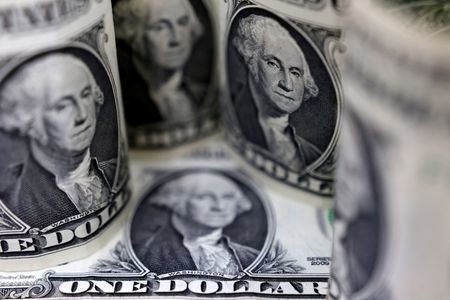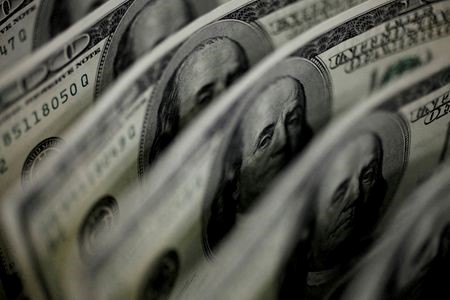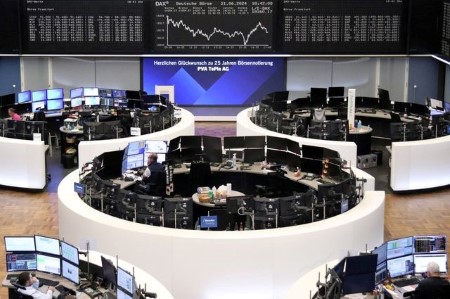NEW YORK, June 26 – The yield curve inversion between the two-year and the 10-year notes deepened on Tuesday to more than 50 basis points for the first time this year, then partly reversed after strong demand at a two-year auction nudged that yield off its highs.
The 2s/10s spread is the most widely monitored section of the yield curve. Normally the yield curve is upward sloping, with shorter-term securities yielding less than longer maturities that entail more risk. The curve has been negative since mid 2022, a sign that the market expects a recession to materialize.
This has not happened yet, despite the Federal Reserve raising short term rates from March 2022 to July 2023 to rein in inflation. The Federal Reserve has signalled all year it is prepared to start easing once inflation comes down enough, and/or if other data, especially unemployment, starts pointing to significant slowing.
Right now the earliest the market sees a pivot is September and many are starting to wonder if the Fed will ease this year at all.
Tuesday’s economic data did not give straight signals. U.S. single-family home prices rose 0.2% in April after being unchanged in March. U.S. consumer confidence eased in June, with the index at 100.4 from a downwardly revised 101.3 in May, according to the Conference Board.
So, trade was relatively cautious ahead of Friday’s release of the May personal consumption expenditure inflation index, which may give more clues on the timing and extent of any cuts. The June payrolls report comes the following Friday.
“At the end of the day the Fed lowers rates because of the labor market and not because of inflation coming down,” said Lou Brien, market strategist at DRW Trading in Chicago. “If you look at the past 30-35 years the Fed reacts to the rise in the unemployment rate, and inflation, partly because it’s lulled us to sleep, has not been the primary factor.”
On Tuesday 2s/10s hit -51.6 basis points, its most inverted since December and was about -50 basis point late in the day, compared to Monday’s -49.1 bp.
Brien said that looking back, the Fed has tended to lower rates when the unemployment rate was one or two tenths of a percentage point above the cyclical low. It reached a record low 3.4% in April 2023 and gradually rose by six tenths to 4% in May with no cut.
Federal Reserve Governor Michelle Bowman on Tuesday said that holding the policy rate steady “for some time” will probably be enough to bring inflation under control, but also repeated her willingness to raise borrowing costs if needed.
Fed Governor Lisa Cook said it would be appropriate to cut interest rates “at some point” given significant progress on inflation and a gradual cooling of the labor market. She remained vague, however, about the timing of the easing.
“Maybe that’s why you are seeing more of an inversion of the curve, simply because there is getting to be a little bit of nerves on the labor market and what that might mean for the Fed.”
The yield on the two year note pared gains after the Treasury sold USD 69 billion at a high yield of 4.706%. That was about 5 bp below where the when-issued notes were trading at the close of bidding, indicating investors were eager to accept a yield below market rates.
The bid-to-cover ratio was 2.75, the highest since August 2023.
Two-year yields, which typically move in step with interest rate expectations, were 0.4 basis points higher than late Monday at 4.7381%. The yield on benchmark U.S. 10-year notes fell 0.8 basis points to 4.24%.
The Treasury has scheduled USD 183 billion in coupon debt to be auctioned this week, split between the two-year notes and five- and seven-year notes to be sold on Wednesday and Thursday.
Yields were moving lower in early morning trade but the release of Canada inflation data, which surprised on the upside, reversed that trend.
“Treasuries had a good bid this morning until the CPI (consumer price index) data in Canada came out and wiped away the Treasury rally,” said Tony Farren, managing director at Mischler Financial Group. Treasury prices and yields move in opposite directions.
On Tuesday, traders of futures contracts tied to the Fed’s policy rate were betting on two 25 basis point rate cuts this year, with a first cut in September seen as having a 61% probability.
Reporting by Davide Barbuscia, Editing by Franklin Paul and Nick Zieminski







 DOWNLOAD
DOWNLOAD











